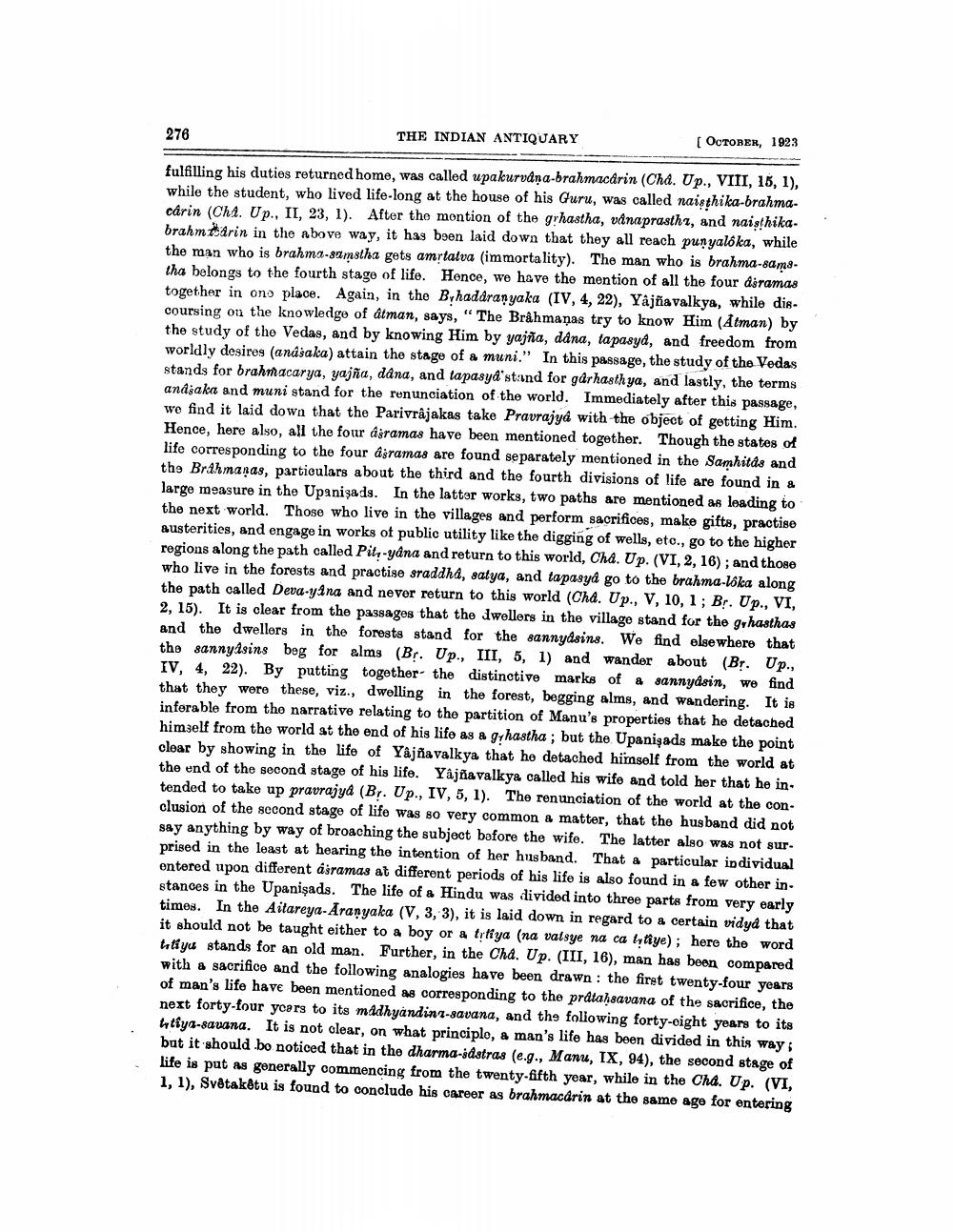________________
276 THE INDIAN ANTIQUARY
(OCTOBER, 1923 fulfilling his duties returned home, was called upakurvdna-brahmacarin (Cha. Up., VIII, 16, 1). while the student, who lived life-long at the house of his Guru, was called naisthika-brahmacarin (Cha. Up., II, 23, 1). After the montion of the grhastha, vanaprasthz, and naisthika. brahmtarin in the above way, it has been laid down that they all reach punyalóka, while the man who is brahma-samstha gets amrtatva (immortality). The man who is brahma-samatha belongs to the fourth stage of life. Hence, we have the mention of all the four asramas together in one place. Again, in the Byhaddranyaka (IV, 4, 22), Yajñavalkya, while discoursing on the knowledge of atman, says, "The Brâhmanas try to know Him (Åtman) by the study of the Vedas, and by knowing Him by yajña, dana, tapasyd, and freedom from worldly desires (anášaka) attain the stage of a muni." In this passage, the study of the Vedas stands for brahmacarya, yaja, dana, and tapasyd'stand for gdrhasth ya, and lastly, the terms andsaka and muni stand for the renunciation of the world. Immediately after this passage, we find it laid down that the Parivrâjakas take Pravrajyd with the object of getting Him. Hence, here also, all the four agramas have been mentioned together. Though the states of life corresponding to the four asramas are found separately mentioned in the Samhitas and the Brahmanas, particulars about the third and the fourth divisions of life are found in & large measure in the Upanisads. In the latter works, two paths are mentioned as leading to the next world. Those who live in the villages and perform sacrifices, make gifts, practise austerities, and engage in works of public utility like the digging of wells, eto., go to the higher regions along the path called Pit-yana and return to this world, Cha. Up. (VI, 2, 16); and those who live in the forests and practise sraddha, satya, and tapasyd go to the brahma-loka along the path called Deva-yina and never return to this world (Cha. Up., V, 10, 1; Br. Up., VI, 2, 15). It is clear from the passages that the dwellers in the village stand for the grhasthas and the dwellers in the forests stand for the sannydsins. We find elsewhere that the sannyasins beg for alms (Br. Up., III, 5, 1) and wander about (Bt. Up., IV. 4. 22). By putting together the distinctive marks of a sannydsin, we find that they were these, viz., dwelling in the forest, begging alms, and wandering. It is inferable from the narrative relating to the partition of Manu's properties that he detached himself from the world at the end of his life as a grhastha ; but the Upanişads make the point clear by showing in the life of Yâjñavalkya that he detached himself from the world at the end of the second stage of his life. Yajñavalkya called his wife and told her that he intended to take up pravrajya (Br. Up., IV, 5, 1). The renunciation of the world at the conclusion of the second stage of life was so very common a matter, that the husband did not say anything by way of broaching the subject before the wife. The latter also was not sur. prised in the least at hearing the intention of her husband. That a particular individual entered upon different asramas at different periods of his life is also found in a few other instances in the Upanişads. The life of a Hindu was divided into three parts from very early times. In the Aitareya-Aranyaka (V, 3, 3), it is laid down in regard to a certain vidya that it should not be taught either to a boy or a trtiya (na valsye na ca lytiye); here the word totiyut stands for an old man. Further, in the Cha. Up. (III, 16), man has been compared with a sacrifice and the following analogies have been drawn : the first twenty-four years of man's life have been mentioned as corresponding to the pratahsavana of the sacrifice, the next forty-four years to its madhyandini-savana, and the following forty-eight years to its htfys-8auana. It is not clear, on what principlo, a man's life has been divided in this way but it should be noticed that in the dharma-sdstras (e.g., Manu, IX, 94), the second stage of life is put as generally commencing from the twenty-fifth year, while in the Cha. Up. (VI, 1, 1), Svêtaketu is found to conclude his career as brahmacarin at the same age for entering




